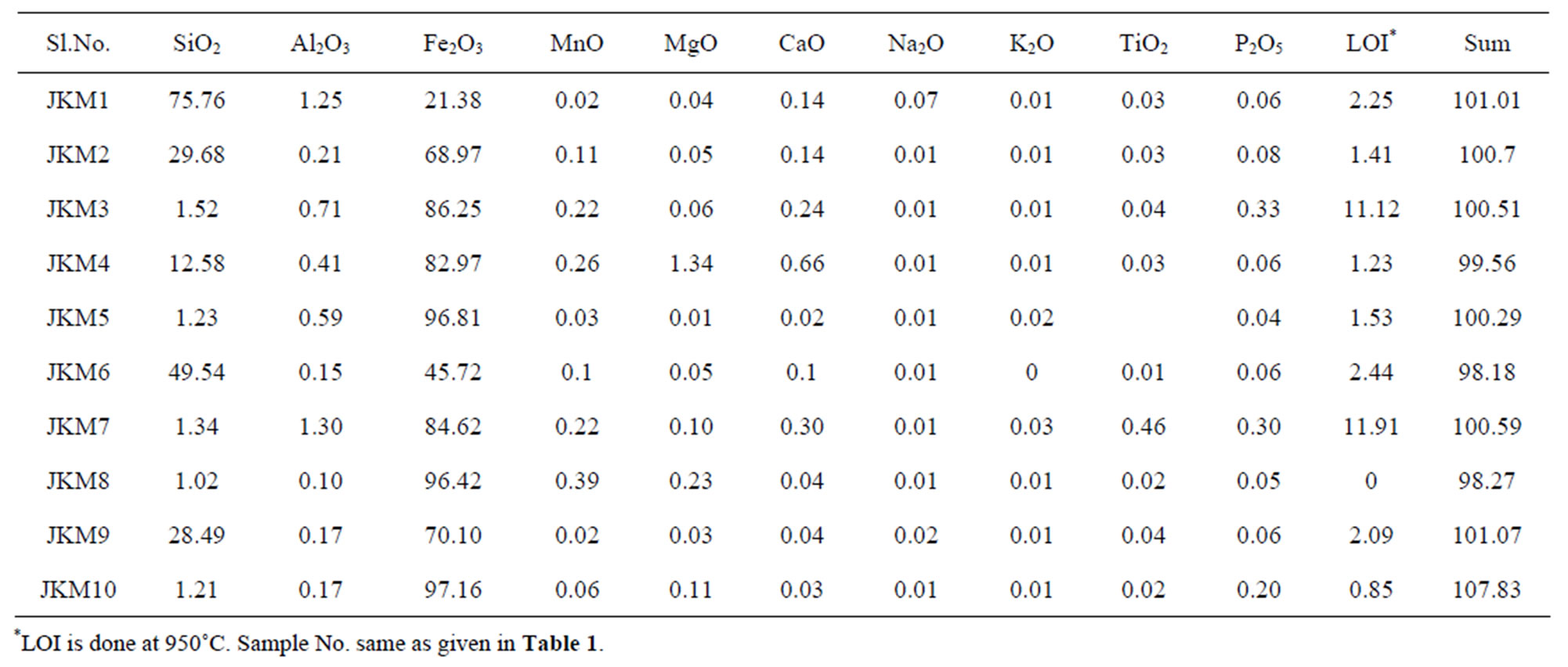Journal of Minerals and Materials Characterization and Engineering
Vol.1 No.5(2013), Article ID:37219,4 pages DOI:10.4236/jmmce.2013.15042
Comment on “Integrated Mineralogical Characterization of Banded Iron Ores of Orissa and Its Implications on Beneficiation” by Mohanty et al. (2012), Journal of Minerals and Materials Characterization and Engineering, 11, 1133-1142*
Tata Institute of Fundamental Research, Mumbai, India
Email: pranaba@hotmail.com
Copyright © 2013 Pranaba K. Nayak. This is an open access article distributed under the Creative Commons Attribution License, which permits unrestricted use, distribution, and reproduction in any medium, provided the original work is properly cited.
Received June 9, 2013; revised July 11, 2013; accepted July 21, 2013
Keywords: Mössbauer Spectroscopy; Banded Iron Formation; Goethite; Magnetite; Hematite
ABSTRACT
Mohanty et al. (2012) have wrongly analyzed Mössbauer spectra obtained from various iron ore samples. We criticized their approach suggesting suitable methodology, and suggested to refer earlier work carried out by Nayak et al. (2001, 2004) on representative samples from the same geological belt.
In response to the article by Mohanty et al. (2012) [1], I wish to bring few technical facts to your kind attention, which I believe questions some of important aspects of results and interpretation presented in this article. Authors have advocated an integrated approach for analyz ing iron ores using various characterisation techniques such as megascopic, microscopic, XRD, Mössbauer spectroscopy, VSM and chemical analysis. However, I understand that authors have wrongly analysed the Mössbauer spectra obtained from samples JKM-03, JKM-07 and JKM-10 presented in Figure 6, resulting inaccurately presented results in Table 1.
For sample JKM-03, authors have identified hematite and goethite from XRD, whereas they fitted corresponding Mössbauer spectrum with four sextets in Figure 6. This is conceptually wrong, as only two sextets required here, one each for hematite and goethite. Additional sextet can only be fitted, in case there is substantial amount of aluminium present in the sample with possibility of partial substitution of iron by aluminium at goethite lattice site [2], as aluminium substituted goethite has reduced field than goethite. But in this case as aluminium concentration is very less (Table 3), and hence the possibility of presence of aluminium substituted goethite effectively ruled out. From the appearance of spectrum of JKM-03 in Figure 6, after fitting two sextets for this sample, I suspect the reduction of field of goethite, which is mostly due to the presence of small particle size involving microcrystallinity of the goethite crystallites, as observed earlier by Nayak et al. [3] in banded iron formations of same geological belt of eastern India. This factor can also result large line width in this type of natural goethite samples. Similarly, for spectra obtained from JKM-07 and JKM-10 presented in Figure 6, there is a need to fit two sextets instead of three and four, respectively and hence the obtained Mössbauer parameters required to be correctly presented in Table 1.
Moreover in Table 1, authors have not provided the expected errors in the calculated Mössbauer parameters making it difficult to understand the significance of the values obtained, and the absence of chi-square (experimental data with fitted data) further limits the understanding of the quality of fitting that authors’ obtained. Furthermore, for samples JKM-04 and JKM-08 collected from BIF 1, authors have identified two sextets as magnetite without any differentiation, and assignment of tetrahedral and octahedral sites is necessary [3,4]. In this context, I would like to mention here that Nayak et al. [3] also studied representative iron ore samples from same geological belt as Mohanty et al. [1] by using complementary techniques such as microscopic, XRD, Mössbauer spectroscopy for characterizing iron-bearing phases, and the outcomes of both studies complement each other. Furthermore, it may be noted here that the technique is called “Mössbauer spectroscopy”, and not “Mossbauer spectroscopy”, as mentioned throughout the paper.
REFERENCES
- J. K. Mohanty, M. S. Jena and A. K. Paul, “Integrated Mineralogical Characterisation of Banded Iron Ores of Orissa and Its Implications on Beneficiation,” Journal of Minerals and Materials Characterization and Engineering, Vol. 11, No. 12, 2012, pp. 1133-1142.
- P. K. Nayak, D. Das, V. Vijayan, P. Singh and V. Chakravorty, “57Fe Mössbauer and EDXRF Studies on Three Representative Banded Iron Formations (BIFs) of Orissa, India,” Nuclear Instruments and Methods in Physics Research Section B, Vol. 184, No. 4, 2001, pp. 649-654.
- P. K. Nayak, D. Das, P. Singh and V. Chakravorty, “57Fe Mössbauer Spectroscopy of Banded Iron Formations from Eastern India,” Journal of Radioanalytical and Nuclear Chemistry, Vol. 260, No. 1, 2004, pp. 19-26.
- P. K. Nayak et al., “Quantitative multielemental analysis of Titaniferous Magnetites by PIXE, EDXRF, and Their Iron Mineral Characterization by 57Fe Mössbauer Spectroscopy,” Journal of Radioanalytical and Nuclear Chemistry, Vol. 254, No. 2, 2002, pp. 351-356.
Appendix

Figure 6. Mossbauer spectra of iron ore samples from different iron formations.

Table 1. Mossbauer parameters of iron ore samples from different iron formations.

Table 3. Chemical analysis of iron ore samples.
NOTES
*http://www.scirp.org/journal/PaperDownload.aspx?paperID=28621.

